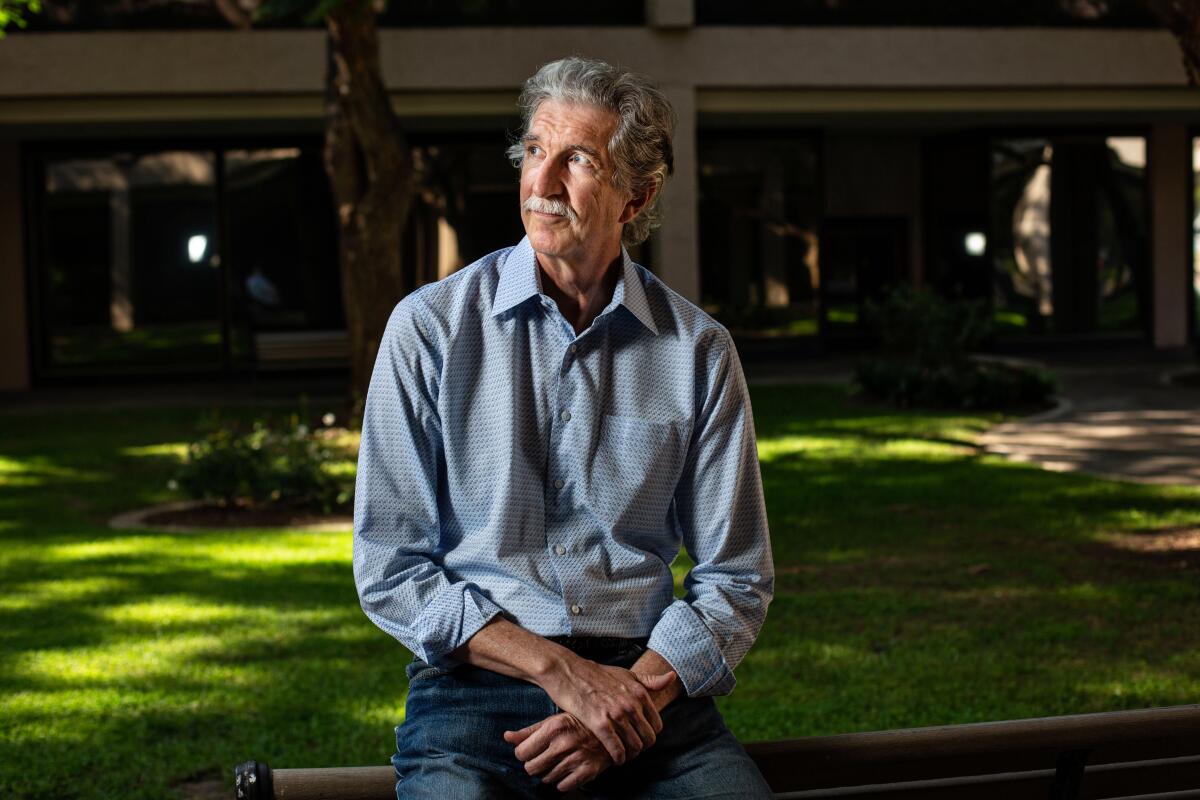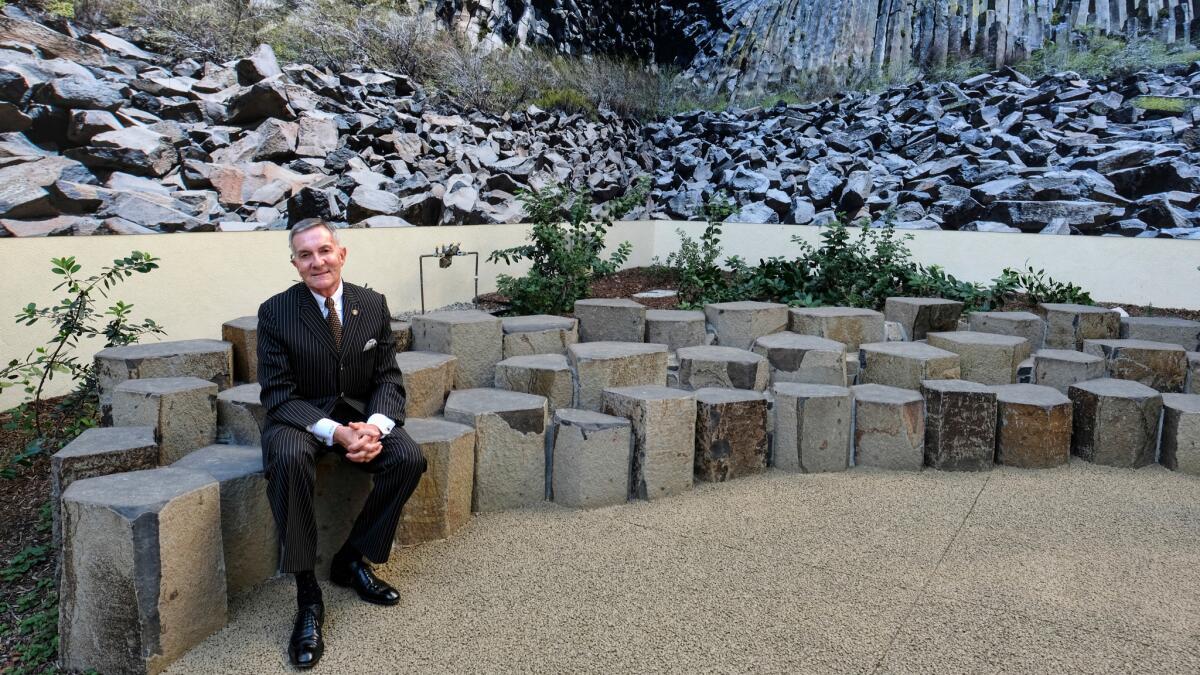Essential Arts: Two endangered Frank Gehry concert hall designs
- Share via
Our choking skies have me thinking of artist Kim Abeles’ “Smog Collectors,” a series of works that use the particulates in smog to fabricate images. I’m Carolina A. Miranda, staff writer at the Los Angeles Times, with the week’s essential arts news:
Gehry’s world
Architect Frank Gehry has made his mark on downtown L.A. with his firm’s design of the Walt Disney Concert Hall and the rising mixed-use building, the Grand, across the street. But the architect has also designed two other performance spaces for downtown: a 1,100-seat concert hall and a 700-seat theater for dance, chamber opera and experimental performance work for the Colburn School. The problem: Fundraising has stalled on the project; Gehry has nonetheless released renderings. Times classical music critic Mark Swed has the scoop — and the images.
Speaking of Gehry: He has a good convo with the Guardian’s Rowan Moore about his monument to Dwight D. Eisenhower in Washington, D.C., which — after much controversy — is scheduled to open to the public next week.
On monuments
The Flight 93 National Memorial in Western Pennsylvania has been 15 years in the making. Last week, one of the final elements was installed: a complex 93-foot wind chime in honor of the passengers and crew killed at the site on 9/11. Leading the design team has been the Los Angeles firm of Paul Murdoch Architects. The 2,200-acre site is less about creating a single iconic monument and more about integrating built and sonic elements into the landscape. “It’s a choreography of natural and commemorative moments,” says Murdoch. “Those who can walk, it gives them time to reflect on what they’ve seen.”

ARCH Production & Design NYC, which fabricated the chimes, created a stop-motion video of the installation process. The National Park Service’s website has an audio simulation of the chimes’ tones.
Both President Trump and Joe Biden traveled to the site on Friday to commemorate 9/11.
Make the most of L.A.
Get our guide to events and happenings in the SoCal arts scene. In your inbox every Monday and Friday morning.
You may occasionally receive promotional content from the Los Angeles Times.
And since we’re on the subject of monuments and 9/11, arts writer Hrag Vartanian writes in Hyperallergic that it’s time to do away with the Tribute in Light memorial that is staged annually in downtown Manhattan. The project, facilitated by the arts nonprofit Creative Time, first appeared in 2002. Back then, writes Vartanian, it seemed like “a joyous gesture” at a moment of national trauma. But he notes that, over time, the tribute has become “a monument to nationalism.”
Coronavirus and the arts
Actor Andrew Scott of the BBC series “Sherlock” — and “Fleabag’s” “hot priest” — recently took to the virtual stage as part of streaming production offered by London’s Old Vic. “It was,” writes Times theater critic Charles McNulty, “among the finest performances I’ve seen since COVID closed the theaters.” The one-man play by Stephen Beresford, titled “Three Kings,” about a son’s relationship to his absent father, is a “small yet well-measured tale” that is “elevated by the actor’s art.” Hoping for a repeat engagement.
Plus, Mark Swed comes through with another column for his deep listening series, tuning into John Cage’s String Quartet in Four Parts. “Completed in 1950, it comes at the end of Cage’s more traditional pieces, before he gave himself over to chance operations in the making of art,” he writes. “It is also, and not coincidentally, the most exquisitely colored and just plain beautiful American string quartet of its time.”
Find Swed’s entire “How to Listen” series right here.
Enjoying this newsletter? Consider subscribing to the Los Angeles Times
Your support helps us deliver the news that matters most. Become a subscriber.
Broadway star Nick Cordero lost his life to COVID-19. Now his castmates are getting together to honor him with a tribute special on the streaming service Broadway on Demand that will go down on Sunday at 4 p.m. The Times’ Christi Carras has all the deets.
Big moves
The Autry Museum’s president and chief executive W. Richard West has announced that he’ll retire from his post in 2021, reports Deborah Vankin. Since assuming leadership of the museum in 2013, he has been credited with transforming the Autry into an important showcase of contemporary indigenous artists. He will be succeeded by UCLA history professor emeritus Stephen Aron.

In the opera world, director Yuval Sharon, founder of the experimental L.A. opera company the Industry, is taking on another gig: He has just been appointed artistic director of the Michigan Opera Theatre in Detroit, reports Mark Swed. He will kick off his new position by staging Wagner’s “Götterdämmerung” in a parking garage next month, for which audience members will stay in their cars. “This is not a time for empty celebration,” he tells Swed. “When we come back, we need transforming experience.”
Plus, Tracy Brown reports on the Academy Museum of Motion Pictures debut exhibition, which will be devoted to Japanese filmmaker Hayao Miyazaki. The show, the filmmaker’s first retrospective in the U.S., will feature more than 300 objects, as well as immersive environments. In one section, visitors will follow a path inspired by the one taken by Mei in “My Neighbor Totoro,” in which she travels through a tunnel of trees and encounters the magical creature Totoro. “That feeling of being free-spirited and adventurous and curious ... is something we tried to re-create,” says exhibition curator Jessica Niebel.
P.S. A sure fire way of mitigating pandemic/wild fire blues is to watch anything by Miyazaki.
Essential happenings
The Times’ Matt Cooper has 18 picks for weekend arts and culture, including a stream of a 2019 site-specific dance piece by Buglisi Dance Theatre at Lincoln Center that pays tribute to 9/11. The broadcast includes a new prologue, performed live, that features dances from an array of companies, including Ailey II and Martha Graham.
This week I ventured out into the haze to see Duke Riley’s solo show “Far Away” at Charlie James Gallery in Chinatown. The show unites his various interests, including the graphics of colonial seafaring and a more recent fascination with pigeon keeping. And I wanted to share this tiny detail from a large-scale (nearly 11-ft. tall drawing) that seems to perfectly embody California’s current mood:

“Far Away” is on view until Oct. 17 by appointment.
In other news
— StreetsBlog LA has a really interesting story on how a plan to make Melrose more bicycle friendly got killed by a NIMBY group and Councilman Paul Koretz.
— Kimberly Dowdell, the president of the National Organization of Minority Architects, is challenging the profession to double Black representation in the field from 2% to 4% by 2030.
— LACMA architect Peter Zumthor will be the subject of a new documentary by Wim Wenders.
— Architect Paul Rudolph’s eccentric headquarters building for Burroughs-Wellcome is threatened with demolition in North Carolina. (See more pix, including incredible vintage color shots, here.)
— How a font named for architect Richard Neutra, who espoused a philosophy of low-cost building, became a design signifier of gentrification.
— Longform podcast has a good convo with essayist, poet and artist Claudia Rankine, author of the new book “Just Us: An American Conversation.”
— Artist Wendy Red Star talks about guest editing Aperture’s upcoming issue devoted to Indigenous artists.
— The British Museum has acquired a trove of 103 drawings by Hokusai that have been in a private collection for more than 70 years. And lucky for us, the museum has put them all online.
— “When I sit down at the end of the week to watch my neighbor’s funeral, the Zoom link does not work.” Edwidge Danticat is just the right person to write about mourning in a pandemic.
— And, because it’s 2020: “A black hole may be lurking in the outer reaches of our solar system.”
And last but not least ...
The PoMo joy of Esprit.
Stay safe, everyone. It’s grim out there.
The biggest entertainment stories
Get our big stories about Hollywood, film, television, music, arts, culture and more right in your inbox as soon as they publish.
You may occasionally receive promotional content from the Los Angeles Times.




